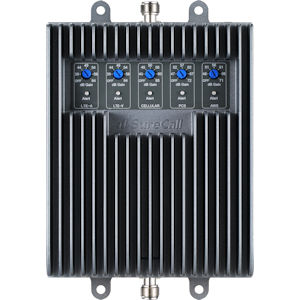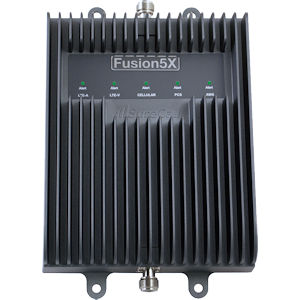What are the differences between the SureCall Fusion5s and SureCall Fusion5X 2.0?
SureCall Fusion5s (SC‑POLYSH/O‑72) vs. SureCall Fusion5X 2.0 (SC‑FUSION5X2)
SureCall’s Fusion5s and Fusion5X cell phone signal boosters may look similar, but key differences between them will determine which will work best in your home or office.
Price
- SureCall Fusion5s: $850
- SureCall Fusion5X 2.0: $1,399
These boosters are separated by a $550 price difference, which puts them in different market segments. The Fusion5s is priced for large homes and small offices, while the Fusion5X is a commercial booster for small to mid-sized offices and buildings.
Booster design
- SureCall Fusion5s: Metal case
- SureCall Fusion5X 2.0: Metal case
The Fusion5s and Fusion5X share the same durable metal case with integrated heat sink.
Both boosters receive power from the same 12V/3A switching power supply, plugged into a 120V AC wall outlet.
Gain
Gain is the booster’s increase in the signal strength it receives from the outside antenna, measured in dB (decibels).
- SureCall Fusion5s: +72 dB maximum gain
- SureCall Fusion5X: +72 dB maximum gain
The Fusion5s and Fusion5X are both rated at the maximum gain the FCC allows for carrier-preapproved five-band cell signal boosters. 72 dB is higher than most other carrier-agnostic boosters available from other manufacturers.
Uplink power
Uplink is the power output, expressed decibel milliwatts (dBm), that the booster uses to communicate with cell towers. The more uplink power, the greater the booster’s ability to communicate with distant towers.
- SureCall Fusion5s: 20.2 dBm average across all bands
- SureCall Fusion5X: 22.1 dBm average across all bands
The Fusion5X has 55% more uplink power than the Fusion5s. This makes the Fusion5X the better choice in areas where outside cell signal is weak.
Downlink power
Downlink is the power output, expressed decibel milliwatts (dBm), that the booster uses to communicate with cellphones and other cellular devices inside the building.
- SureCall Fusion5s: 9.2 dBm average across all bands
- SureCall Fusion5X: 14.9 dBm average across all bands
The Fusion5X has nearly four times more downlink power than the Fusion5s. The additional downlink power in the Fusion5X gives it the ability to handle more users—essentially, it has a bigger “pipeline.” This is critical for businesses that have more simultaneous users and greater demands on cellular data usage.
Indicator lights
- SureCall Fusion5s: LED lights
- SureCall Fusion5X: LED lights
The Fusion5s and Fusion5X both have LED lights on the front to indicate the amplifier’s status on different cellular frequencies. (The user manuals for the Fusion5s and Fusion5X explain how to interpret the lights.)
Gain controls
 The Surecall Fusion5s has optional manual gain control for each of the five cellular bands
The Surecall Fusion5s has optional manual gain control for each of the five cellular bands
- SureCall Fusion5s: Automatic gain control and manual gain control by band
- SureCall Fusion5X: Automatic gain control
Both the Fusion5X and the Fusion5s will automatically increase and decrease the gain on individual cellular bands to deal with overly strong or weak outside signal. The Fusion5s, however, also has five small knobs that can manually turn down or turn off the gain on individual bands of signal.
It’s not often that you need to manually adjust the gain of a cell signal booster, but if this capability is important in your situation, the Fusion5s is the better option.
Connectors
- SureCall Fusion5s: N connectors
- SureCall Fusion5X 2.0: N connectors
Both boosters attach to outside and inside antennas with commercial-grade N connectors.
Coax cable
- SureCall Fusion5s: 400-type (−3.7 dB signal loss per 100 feet)
- SureCall Fusion5X: 400-type (−3.7 dB signal loss per 100 feet)
The Fusion5s and the Fusion5X 2.0 are both 50-ohm systems that come standard with 400-type coax cable. Powerful Signal also offers upgraded half-inch coax cable with nearly half the signal loss of 400 cable, allowing for longer runs of cable in large buildings.
See our Complete Guide to Coax Cable for more information about types of cable for cell signal booster systems.
Antennas
antenna
- SureCall Fusion5s: Outside omni, inside dome
- SureCall Fusion5X 2.0: Outside omni, inside thin dome
Powerful Signal’s Fusion5s kit includes a 7.3″ × 3.3″ inside dome antenna. Our Fusion5X kit features a low-profile 7.5″ × 0.3″ flat dome antenna.
Both antennas look neat and professional in homes and offices.
Best uses
- SureCall Fusion5s: Small offices with a handful of users and most large homes
- SureCall Fusion5X 2.0: Offices with more users and homes with weaker outside signal
The Fusion5s is usually the better solution for homeowners and for small offices with a handful of employees and/or customers who need improved cell signal. It’s also the best choice if you’re in the unusual circumstance of needing to turn down or turn off a specific band of cellular signal.
The Fusion5X is more powerful than the Fusion5s; it can cover more square footage and connect to more distant cell towers. This makes the Fusion5X the better solution for larger offices and for homes that are in remote areas with very weak outside cell signal.





